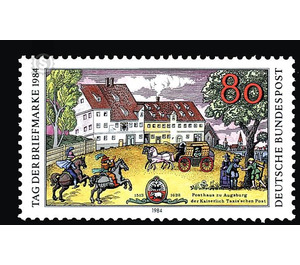day of the stamp - Germany / Federal Republic of Germany 1984 - 80 Pfennig
Theme: Animals
| Country | Germany / Federal Republic of Germany |
| Issue Date | 1984 |
| Face Value | 80.00 |
| Color | multi-colored |
| Perforation | K 14 |
| Printing Type | Six-color offset printing |
| Stamp Type | Postage stamp |
| Item Type | Stamp |
| Chronological Issue Number | 1102 |
| Chronological Chapter | GER-BRD |
| SID | 421186 |
| In 45 Wishlists | |
The German Federal Post Office honors the "Stamp Day", this "Philatelic Festival", by issuing a special postage stamp this year for the tenth time in an uninterrupted series. The Bund Deutscher Philatelisten eV, the umbrella organization for organized philately with around 90,000 registered members and a much larger number of friends, is responsible for the central events that took place on Stamp Day 1984 (October 28, 1984) by German philatelists and youth groups - Youth to be performed in eleven cities: Augsburg - Beckum - Berlin - Cuxhaven - Frankfurt - Hanover - Herten - Kiel - Merschweiler - Siegburg - Sindelfingen. The events are supposed to introduce new friends to the »Philatelie« hobby. The motif of the stamp goes back in the history of the postal service. At the end of the 15th century, the widely ramified Taxis family, headed by Franz von Taxis (1459-1517), began to build equestrian and courier services in western Europe, with all the patents and imperial privileges of the Habsburg rulers. Initially, they were official messages between the courts and centers of power of Emperor Maximilian I (1459-1519) and his successor Emperor Charles V (in whose realm "the sun never set") in Germany, Austria, Tyrol, Italy and Spain changed. Soon afterward, the messengers also took non-official letters from private clients to private recipients, so that the dynastic courier service quickly became a generally accessible institution: the first German post office. The number of postal rates rose steadily, and as early as 1550 a contemporary chronicler rejoiced: "The invention of the sentries is cheap to count among the blessings of present times!" The Augsburg location, home to a family of taxis, was of particular importance from the very beginning to. The old imperial city was initially the only city on the "Old Course" Innsbruck-Brussels. At the same time, it was the junction and junction to the Imperial Court Post (also under the direction of taxis), with which a permanent connection between the residential cities of Prague and Vienna as well as the different locations of the Habsburg rulers was established. So there were initially two post offices (Reich and Hofpostamt) in Augsburg, which were led by members of the same Taxis'schen family branch. This fact, however, did not prevent the tensions between the two postmasters - until the two post offices merged in 1564. The stamp shows the post office of the imperial Reichspost in front of the Wertachbrucker gate to Augsburg, after an engraving by L. Kilian from the year 1616. The original and the coat of arms of the Augsburg taxis line in the first day cancel have been slightly changed in artistic freedom. (Text: Bund Deutscher Philatelisten e.V., Federal Office for Public Relations, Frankfurt am Main)


